Artist Spotlight: Charlotte Cullen

Study for a Shield after Battle (After the Knight), 2023 and Study for a Shield after Battle (the Knight gives), 2022, photo by Carlo Zambon
We catch up with Axis Fellowship cohort member, Charlotte Cullen, to chat about their work.
Tell us a bit about yourself and your practice, how would you describe the work that you do?
I’m an artist working in sculpture, primarily I work in metal applying techniques including plasma cutting and welding to create almost fragile feeling steel sculptures. The material becomes torn, scarred and burnt, and the processes from the metal workshop are often still visible. I also bring in techniques such as weaving into metal to create intersecting forms that hold and support themselves. There’s often this return to care and healing amongst all this impact.
These materials and processes come through labour and socially classed labour, working with tools and materials from industry or applying techniques from other forms of labour including textiles and care work. There’s this embodied material experience which holds me to sculpture, and back to hard materials specifically. Over the last year I’ve been developing my skills in stained glass work and have begun integrating this into my metal sculptures.
I’m also engaged with artist-led exhibition practices and organising, with an interest in how socio-economic and political experience shape the material and formal process of artists practice. I completed my practice-led PhD with the Centre for Sculptural Thinking at the University of Huddersfield in 2019. I curate Vessel Gallery in York, which is focused on establishing space for difficult to define and marginal practices at York St John University, where I also lecture. And I’m a member of artist-led studio and project space, serf, in Leeds which is ran by a voluntary committee of artists.
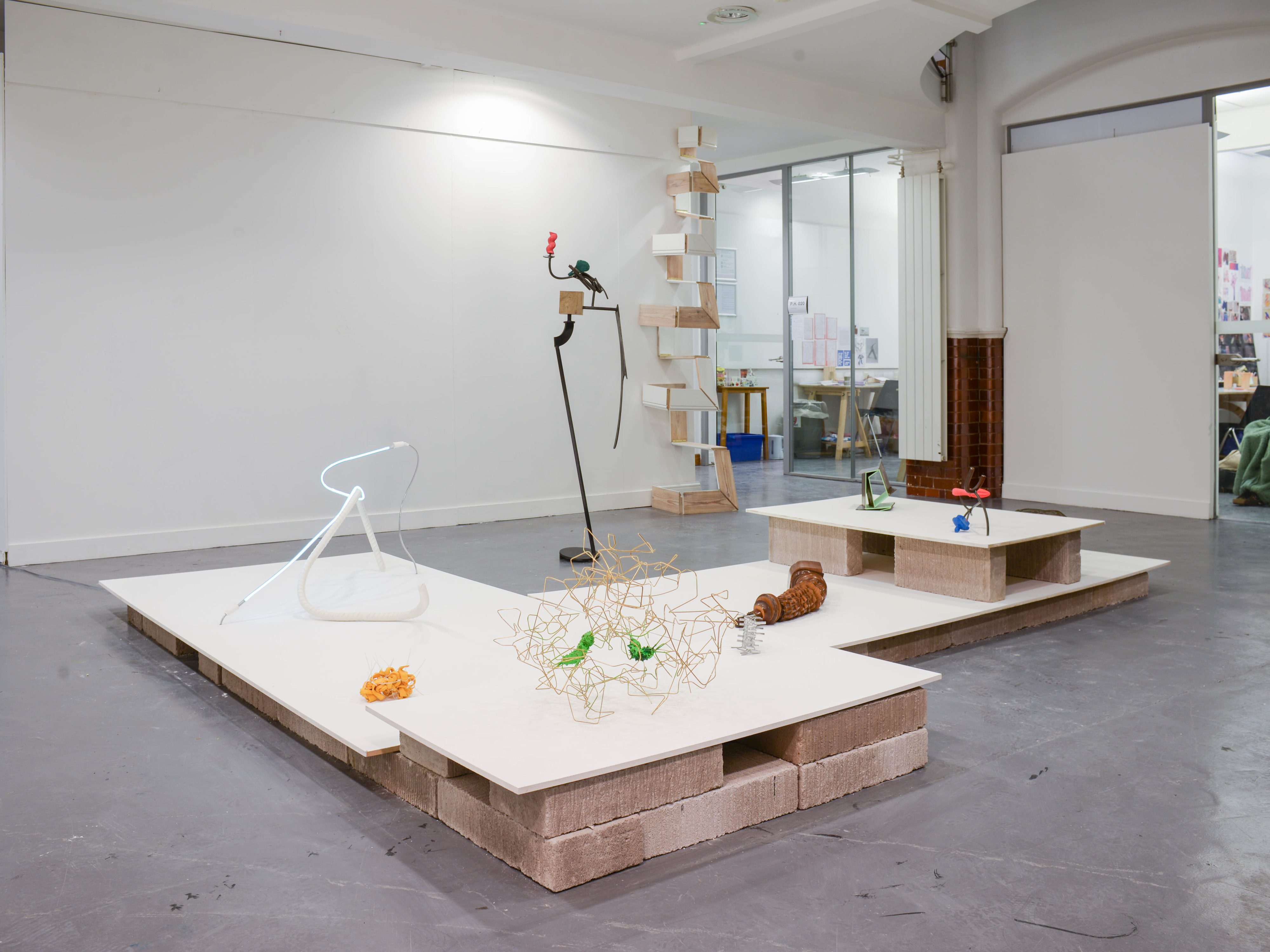
Can you tell us more about how your research and curation intersect with your practice?
Working with others as part of a community, for research and for discussion remains central to my ongoing practice, and was one of the reasons I was thrilled to join the Axis fellowship, the opportunity to extend networks within a supported space.
Over the last year, I convened the symposium and exhibition Talking Sculpture: Dialects of Making. The exhibition was held at Vessel Gallery from Dec 2023 – March 2024 and the one-day symposium concluded the programme, and I’m excited to be able to share the discussions from the day with Axis. This was the largest research project I have undertaken since completing my PhD, and I’m really grateful for the support to have developed and organised the programme.
Talking Sculpture: Dialects of Making asserted the contemporary relevance of abstract sculpture made by artists whose gender impacts their inclusion historically in the field. This national and intergenerational exhibition of abstract sculpture initiates a material discussion of women making abstract sculpture, curators and art historians. In collaboration with the artist group Talking Sculpture Making, Talking Sculpture: Dialects of Making repositions the importance of women and non-binary artists’ contributions to abstract sculpture through community-driven practice as a feminist action. The symposium included a keynote from Professor Griselda Pollock, speakers Dr Julia McKinlay, Dr Victoria Sharples, and Natalie Rudd, Panelists Gillian Brent, Katrina Cowling, Alexandre Harley, Hannah Honeywill, Sheila Vollmer and myself, and chairs Becky Gee, Sam Metz and Sarah Roberts and included a handling session of historic artist books, zines and pamphlets from Leeds Central Library.
You incorporate a lot of 'mark-making' processes in your work, this is evidenced in the 'scars' on your sculptures as well as in your drawing works. Can you tell us more about these processes and how they inform your thinking when making work?
Mark-making is central to my practice and my sculptures are an exercise in material mark-making, fleeting gestures captured in physical forms through process. I didn’t really realise this until I undertook a residency with LUTRA print workshop in 2021. Working with LUTRA helped me recognise that the primary drive of my sculptures was the mark-making the form held, rather than the other way around as I had viewed it before putting my steel offcuts from my sculptures through the printing press. I recognised that rather than a formal enquiry, the form held space for the mark and the lineage of creating a mark – be it graffiti, wear and tear, desire lines, school desk etchings… these ways of life lived creating an impact or change to its environment and specifically how that is held materially outside of historical structures that value privileged lives.
I also think of these marks as scars; material marks which bear the reminder of the process. I primarily use plasma cutting to create my work. It’s an industry process usually used for detail cutting. It’s hot, loud and dirty. I’m interested in how the process can be bastardised, leaving burn marks from leaving the plasma arc focused too long, or skipping too quickly so the metal isn’t cut to create varying depths and impact on the surface. It’s a physical manifestation of the battle with the material.
I tend to draw using a mix of drawing tools, including traditional tools such as pencils and graphite alongside biros, highlighters, felt tip. This developed over lockdown when I couldn’t make in a workshop and gathered what I could find around my home to draw with, lending an immediacy and simplicity to the marks. I draw frequently and these tend to be gestural and exercises in staying present. This helps keep me present in the metal workshop, and over the last year I have begun to incorporate these drawn marks more directly to inform my sculptures.
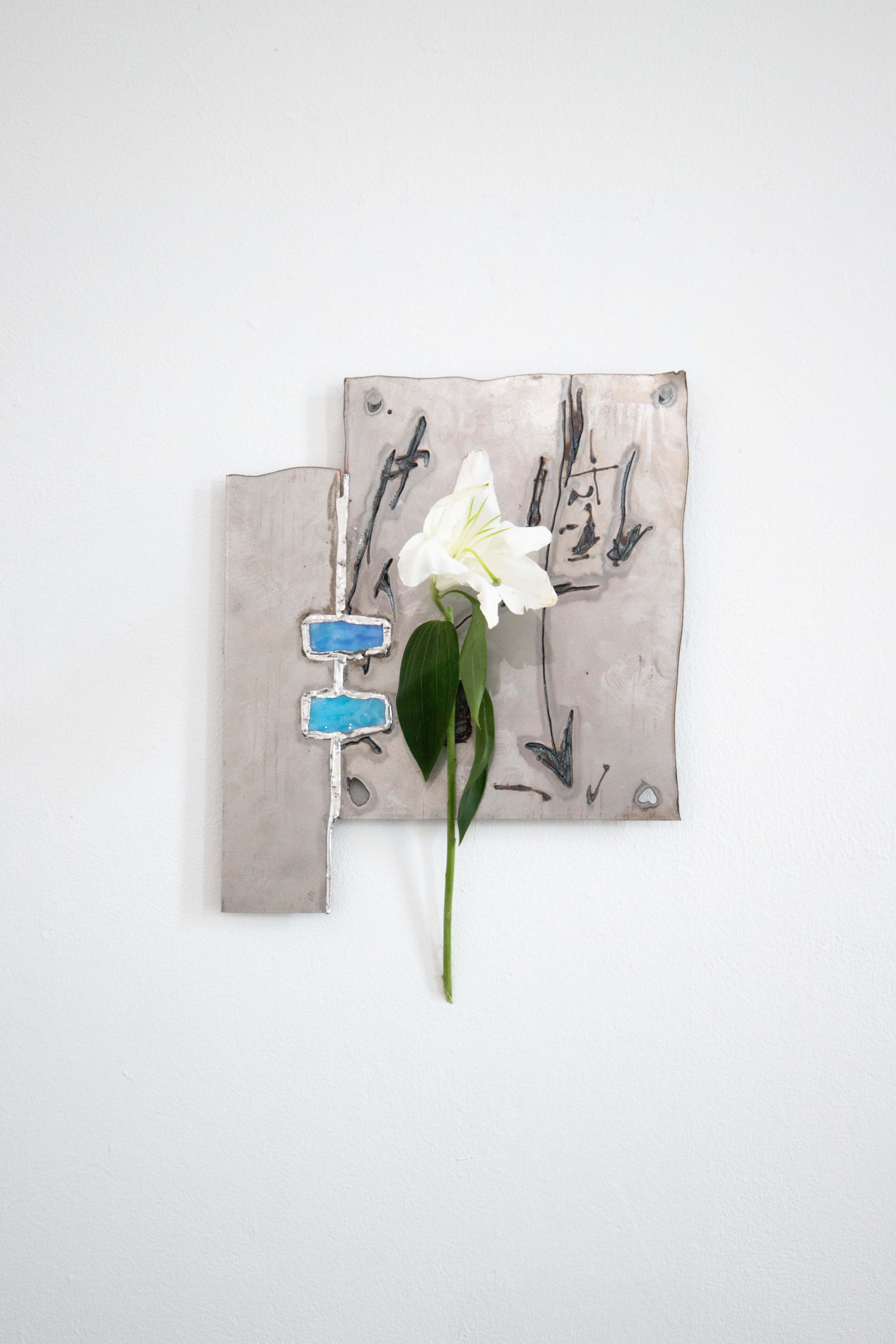
You've previously mentioned the 'permanence of trauma' and the 'pain of intervention' when discussing the use of arrows in your work. Can you tell us more about this?
I applied for the axis fellowship as I hoped to slow down my practice, I wanted to engage purposefully in how I was developing my sculptures and approaching my practice; materially, practically and conceptually. This has developed around a body of work titled ‘She’s the Arrow’, which has been forming over the last year in response to grief.
I tend to work in bodies of practice – multiples of formal and material enquiries which tease out a central motive across different realisations: varying marks, scales, repetitions, and which I commit years to working through. My most recent series ‘Studies for a Shield after Battle’ considered the object of a shield as a formal, material and conceptual device as a stand in for the human body to materialise long-term sickness, disability, failure of the state as battle scars which might be read from an archaeological find: what marks have been left behind, how can lived experiences be read, where do we find the stories of those who have been ignored? There was a sense with these works that the battle was over, lost. They were rooted, static, permanent.
In this new body of work, I’m drawn to the shattering of action, the arrow has become a symbol for me of this moment of change. It’s piercing and painful, a sudden violence which cannot be undone. In focusing on the arrow, the works presence is trapped in this temporary moment. When we were discussing this in our sessions, there was discussion of how a broken bone heals, an idea that time heals wounds. But I think this is about the times when time does not heal, when you’re trapped in the moment and it becomes a trauma. It’s a different permanence to be held in the moment of change. Its penetrating and consuming. It’s a symbol often incorporated in religious iconography of Catholic saints in their moment of martyrdom, for example, St. Sebastian in whose depiction of multiple penetrating arrows is often homoerotic and joyful.
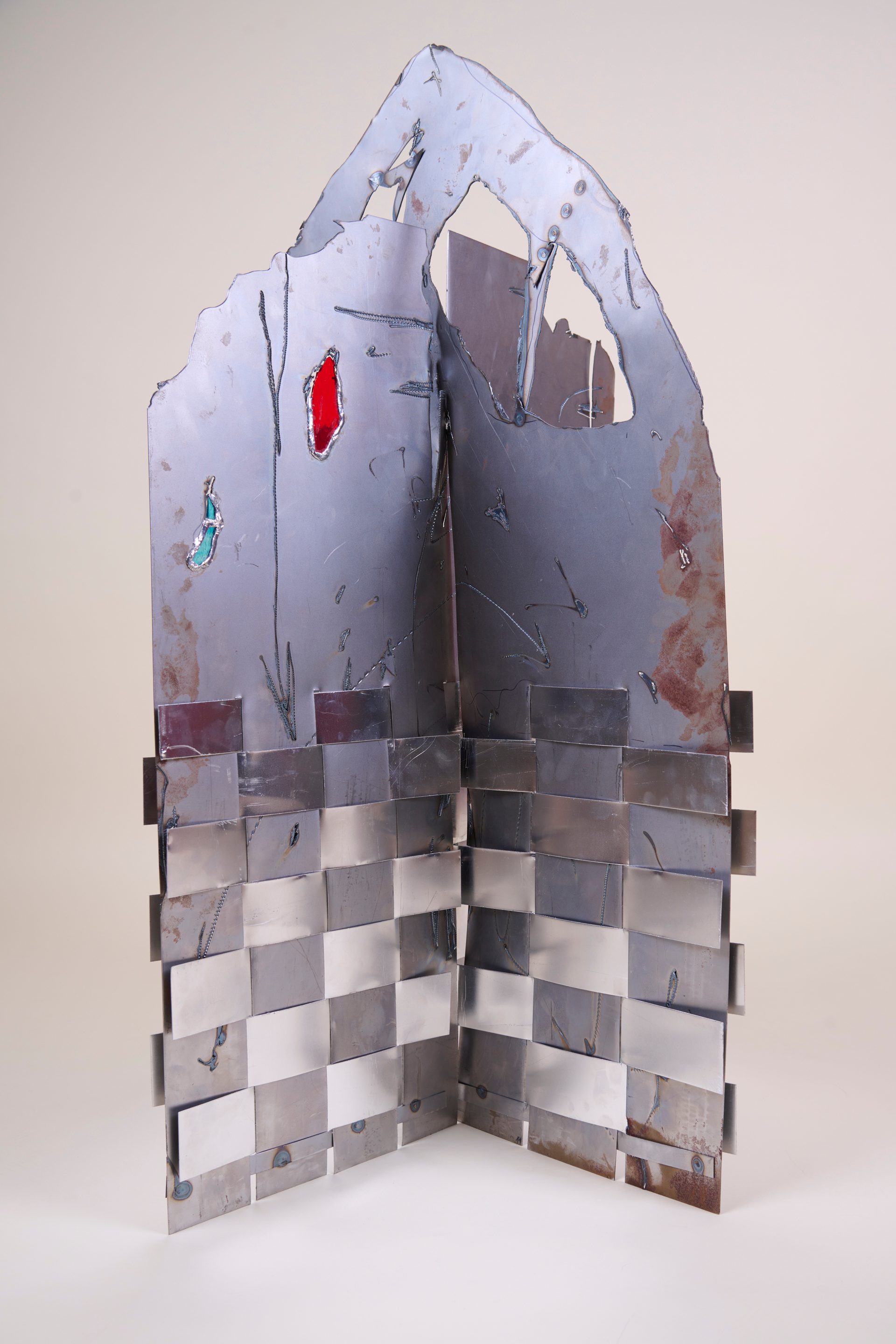
You've recently started incorporating elements of coloured glass into your metal sculpture work. Could you tell us more about this decision and the significance of stained glass in your work?
Religious iconography was a big part of putting together the threads that led to stained glass in my work. Like much of my practice, there are multiple reasons for one material or process, and throughout this interview I’ve done a terrible job at staying succinct! In 2022 I travelled to Italy and was taken by the small religious shrines in the streets and alleys. They were often small-scale interventions which held a strong presence, they were looked after and active, often with fresh flowers and candles burning. It made me aware of how a small presence can be significant in holding space. The shrines are a site of materialising grief as saints can stand in for hope, memory and loss. Growing up in an Irish Catholic immigrant family, shrines and representations of saints were commonplace both in the home and in communal spaces like church. Seeing something similar in another culture made me recognise something I had taken for granted. There wasn’t often stained glass in these shrines, but this thinking led me to think of stained glass in churches, their monumentalism as well as a certain simplicity in their narrative. So, I undertook a workshop in stained glass at Swarthmore College in Leeds and fell in love with the process. Like metal, glass is a hard material and it has limitations which you have to learn and listen to. The actions, such as cutting, are quick, but if the material breaks or doesn’t do what you want you can’t change it – you have to work with the brake or start again. This material conversation keeps me engaged working in metal too. And like metal, the material itself taps into these complex and intersecting lived experiences of the world. In bridging these materials together, I hope I can begin to unpick something knotty and difficult to grasp. Material allows you to do that in a way I find language to be trickier, as we are material so we bring these tacit understandings through our embodied experiences.
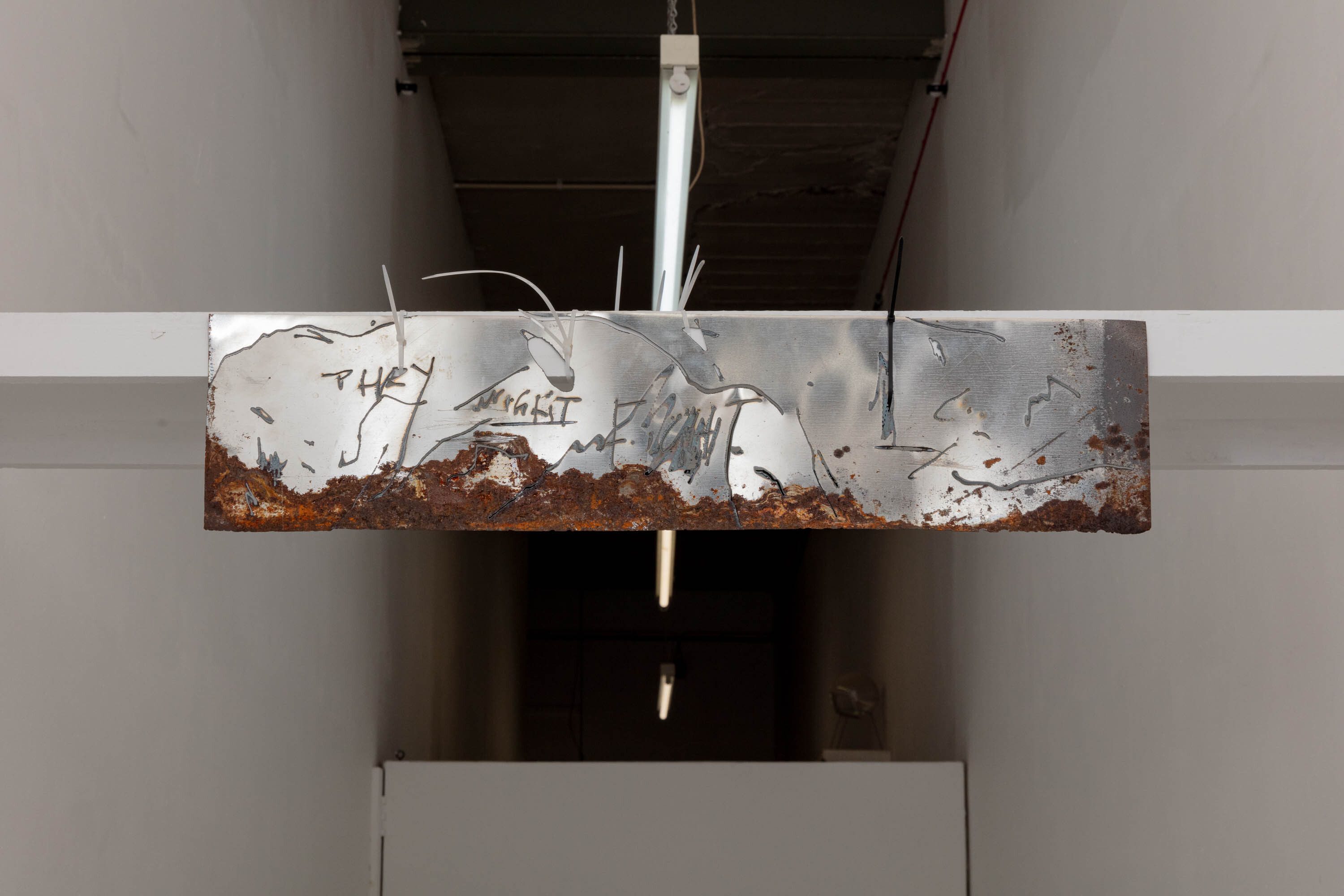
For any artists who are considering applying for this year's fellowship, can you tell them how it has been useful to your practice?
The fellowship has really supported me this year. The fellowship has allowed me to slow down and develop new ways of working purposefully. Thanks to the financial support, discussion and mentorship I’ve begun to develop how I approach my practice, including developing relationships with fabricators. Integrally, community has always been important for me in developing and sustaining my practice, and Axis brought together a really purposeful fellowship of artists. I remember our first session learning about all these cross-overs which have led to different ways of thinking about material, process and concepts across each artists perspective and I’m looking forward to sustaining these friendships long after our fellowship ends. I am so grateful to Harlan and our group for a nourishing year!
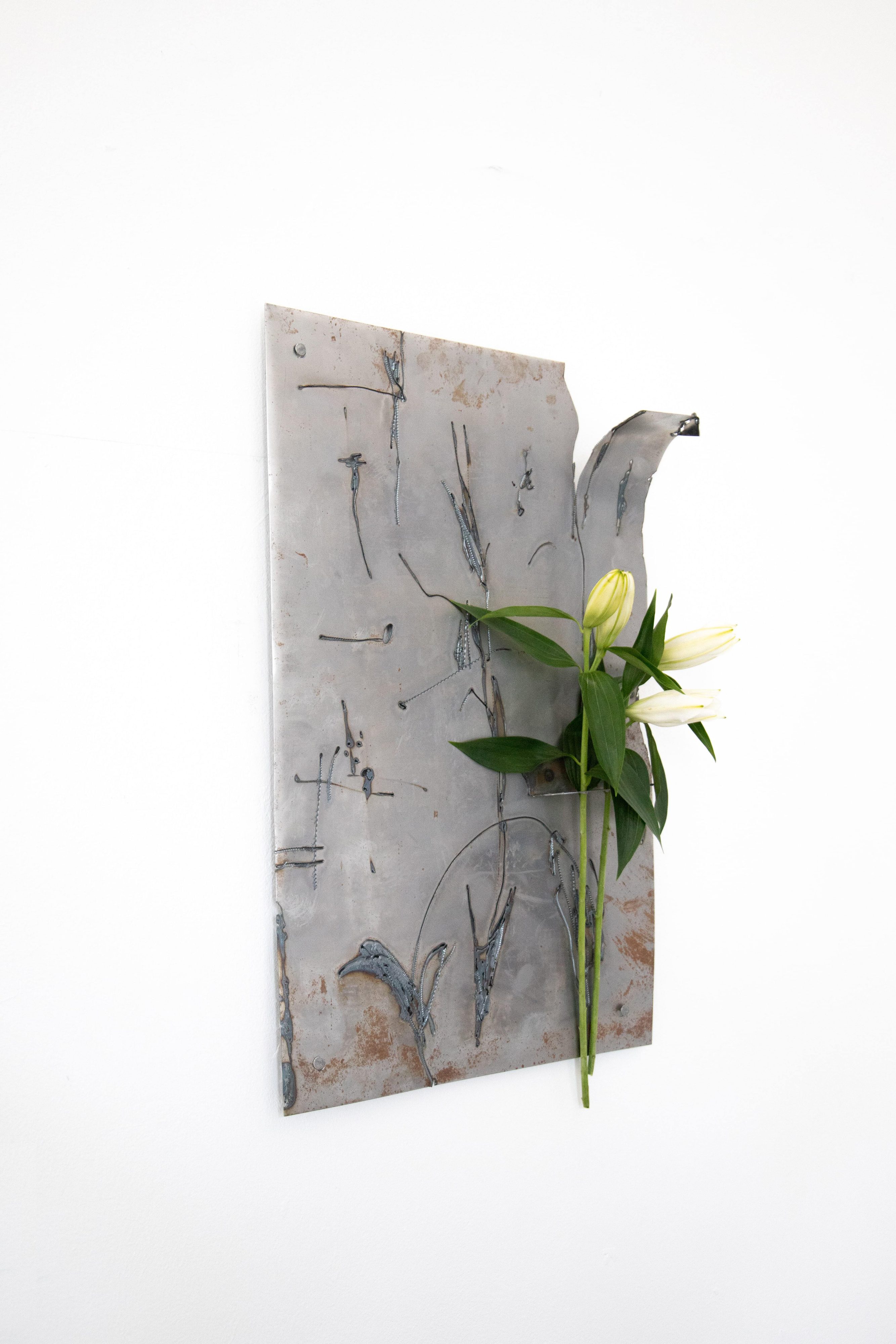
Artists
Share this article
Helping Artists Keep Going
Axis is an artist-led charity supporting contemporary visual artists with resources, connection, and visibility.


